Though not a magic bullet “cure all,” agricultural biotechnologies can and should be used in developing countries to improve smallholder farmers’ livelihoods, but farmers themselves need to be involved in decision making, according to participants at an international technical conference on agricultural biotechnologies last week.
During 01-04 March 2010, roughly 300 people from nearly 70 countries attended the International Technical Conference on Agricultural Biotechnologies in Developing Countries (ABDC-10), organized by the Food and Agriculture Organization (FAO) of the United Nations and held in Guadalajara, Mexico. Attendees included representatives from international organizations, civil society, national governments, and national agricultural research programs. Their goal in gathering was to assess the progress of biotechnologies across various agricultural sectors—crops, forestry, livestock, fisheries, and agro-industries—and to generate a forward-looking consensus on ways that biotechnologies can assist smallholder famers in developing countries.
Investment in and improvement of agriculture is vital for the more than one billion people who go to bed hungry each night, as well as for many farming families who survive on only a few dollars a day. Adoption of effective and cost-efficient agricultural biotechnologies is one way to address the food demands of a rapidly expanding and more affluent world population, while also confronting the challenges of increasing land degradation and climate variability.
“Two billion people live on small farms, about one-third of our population,” said Rodney Cooke, of the International Fund for Agricultural Development (IFAD), while addressing the general session. “Investment in agriculture is two-anda- half-to-three times more effective in increasing the income of the poor than non-agricultural investments.”
The FAO predicts that by 2050 there will be a 70% increase in food demand, requiring at least 170 million more acres of cropland. Meeting this demand looks difficult, because crop yields have slowed from an annual increase of 3-6% to only 1-2%, in the last decade.
Agricultural biotechnologies can sustainably improve food security and help smallholder farmers escape poverty. However, many of these advanced technologies are underutilized in developing countries, where a large portion of smallholder farmers live. Overcoming this will require increased investments, international cooperation, effective national policies and regulatory frameworks, and collaboration with farmers and the various value-chain actors, said ABDC-10 participants. Several farmers and farmer representatives in attendance repeatedly stressed the importance of bottom-up development in applying biotechnology.
During the conference, participants divided their time between plenary sessions in the morning and small group meetings in the afternoon. Topics included region and sector-specific issues, as well as multidisciplinary topics such as empowering public participation in decision making; prioritizing the role of the farmer; and development of genomic resources. All participants discussed successes and failures in biotechnology projects in developing countries. The CGIAR was responsible for leading several group sessions; participating CG members included the International Crops Research Institute for the Semi-Arid Tropics (ICRISAT), the International Center for Agricultural Research in the Dry Areas (ICARDA), CIMMYT, and the Generation Challenge Program (CGP).
CIMMYT director general Tom Lumpkin addressed the plenary session in a presentation on the use of biotechnology in the CGIAR. Tom Payne, head of CIMMYT’s wheat germplasm bank, was a panel member for a group session on the conservation and sustainable use of genetic resources. Jean-Marcel Ribaut, Carmen de Vicente, and Rajeev Varshney (ICRISAT) of the GCP also presented on accessing genetic resources, genomic applications, and molecular breeding in developing countries, respectively.
“To meet the challenges of increased food demand in a sustainable way, biotechnologies are essential for the future,” Lumpkin said, stressing as well that such technologies need to show tangible results and the efficient use of time and money.
Payne explained that the CGIAR has 11 gene banks conserving over 530,000 samples of wild and domesticated crops in public trust, but that these genetic resources are not always accessible or useful to breeders. “There are so many accessions but so little information,” he said, adding that the CGIAR is collaborating on a new portal to improve access to the genetic resources (www.global-alis.org).
Additionally, CIMMYT was represented at the ABDC-10’s knowledge share fair, providing publications and information on the center’s biotechnology work. Highlighted projects included rust resistance wheat, nitrogen use efficient maize for African soils, water-efficient maize for Africa, and the conservation and use of maize and wheat genetic resources.
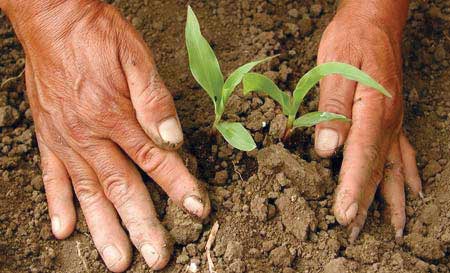 A new era began this week with the launch of the CGIAR Research Program MAIZE, a US$170 million global alliance to expand and accelerate research into maize, on 06 July 2011. The announcement was made during a celebration of the CGIAR’s 40th birthday, held at the World Bank headquarters in Washington, marking a new direction for the CGIAR and demonstrating that after four remarkable decades it remains vigorous and committed to addressing emerging challenges.
A new era began this week with the launch of the CGIAR Research Program MAIZE, a US$170 million global alliance to expand and accelerate research into maize, on 06 July 2011. The announcement was made during a celebration of the CGIAR’s 40th birthday, held at the World Bank headquarters in Washington, marking a new direction for the CGIAR and demonstrating that after four remarkable decades it remains vigorous and committed to addressing emerging challenges.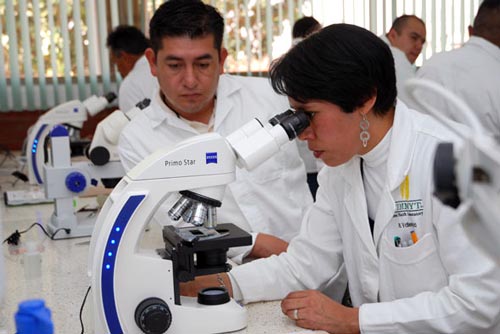 Seed is the lifeblood of CIMMYT’s work. Unfettered shipments, both incoming and outgoing, depend on CIMMYT and partners’ ability to keep seed clean from pathogens and to properly document seed health. To promote protocol consistency among Mexican seed technicians, a weeklong seed-health workshop was held during 29 November-03 December 2010 at CIMMYT-El Batán.
Seed is the lifeblood of CIMMYT’s work. Unfettered shipments, both incoming and outgoing, depend on CIMMYT and partners’ ability to keep seed clean from pathogens and to properly document seed health. To promote protocol consistency among Mexican seed technicians, a weeklong seed-health workshop was held during 29 November-03 December 2010 at CIMMYT-El Batán.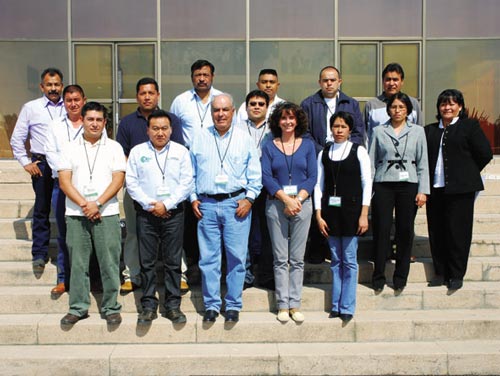 On Tuesday, 30 November, the participants took a break from the lab to enjoy the fresh air of the Tlaltizapán station where they learned field inspection and sample collection procedures. The course focused on diseases prevalent in Mexico and included presentations from Monica Mezzalama as well as two guest lecturers, Ana María Hernández, plant pathologist, and Gustavo Mora, plant disease epidemiologist, both professors from the Colegio de Postgraduados, Texcoco, Mexico. The workshop was the first of its kind, and due to resounding positive feedback, it is hoped to be continued annually. Thanks to all that made the course possible, a special thanks to Noemí Valencia, seed health laboratory supervisor; Gabriela Juárez, research assistant; Laura Rodríguez, training office assistant; and Óscar Bañuelos, Tlatizapán station superintendent.
On Tuesday, 30 November, the participants took a break from the lab to enjoy the fresh air of the Tlaltizapán station where they learned field inspection and sample collection procedures. The course focused on diseases prevalent in Mexico and included presentations from Monica Mezzalama as well as two guest lecturers, Ana María Hernández, plant pathologist, and Gustavo Mora, plant disease epidemiologist, both professors from the Colegio de Postgraduados, Texcoco, Mexico. The workshop was the first of its kind, and due to resounding positive feedback, it is hoped to be continued annually. Thanks to all that made the course possible, a special thanks to Noemí Valencia, seed health laboratory supervisor; Gabriela Juárez, research assistant; Laura Rodríguez, training office assistant; and Óscar Bañuelos, Tlatizapán station superintendent. EL BATAN, 06 September 2010—On a historic day for CIMMYT, Director General Thomas A. Lumpkin and Dr. S Ayyappan, Director General of the Indian Council of Agricultural Research (ICAR), signed a joint declaration of intent in the presence of H.E. Mr. Sharad Pawar, Honorable Minister of Agriculture of India, to establish the Borlaug Institute for South Asia (BISA). Located in India but serving the entire region, BISA will constitute a state-of-the-art, international agricultural research and development organization that applies cutting-edge technologies to improve cropping systems and help farmers address current and emerging challenges to food security such as climate change, natural resource scarcities, and rising market demand. According to the declaration, the new institute commemorates the “…fond and respectful memory of the late Dr. Norman Borlaug, and his contribution to the Green Revolution of India and of South Asia.”
EL BATAN, 06 September 2010—On a historic day for CIMMYT, Director General Thomas A. Lumpkin and Dr. S Ayyappan, Director General of the Indian Council of Agricultural Research (ICAR), signed a joint declaration of intent in the presence of H.E. Mr. Sharad Pawar, Honorable Minister of Agriculture of India, to establish the Borlaug Institute for South Asia (BISA). Located in India but serving the entire region, BISA will constitute a state-of-the-art, international agricultural research and development organization that applies cutting-edge technologies to improve cropping systems and help farmers address current and emerging challenges to food security such as climate change, natural resource scarcities, and rising market demand. According to the declaration, the new institute commemorates the “…fond and respectful memory of the late Dr. Norman Borlaug, and his contribution to the Green Revolution of India and of South Asia.”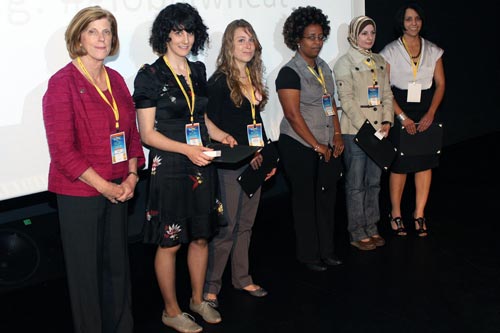 During the special luncheon ‘Jeanie Borlaug Laube’s Women in Triticum Award’ was presented to the first 5 awardees – Hale Ann Tufan (Turkey); Jemanesh Kifetew Haile (Ethiopia); Esraa Alwan (ICARDA), Jessica Rutkoski (USA) and Maricelis Acevedo (USA), followed by special presentation by Eija Pehu (The World Bank) on ‘Gender equity in agricultural research and extension’
During the special luncheon ‘Jeanie Borlaug Laube’s Women in Triticum Award’ was presented to the first 5 awardees – Hale Ann Tufan (Turkey); Jemanesh Kifetew Haile (Ethiopia); Esraa Alwan (ICARDA), Jessica Rutkoski (USA) and Maricelis Acevedo (USA), followed by special presentation by Eija Pehu (The World Bank) on ‘Gender equity in agricultural research and extension’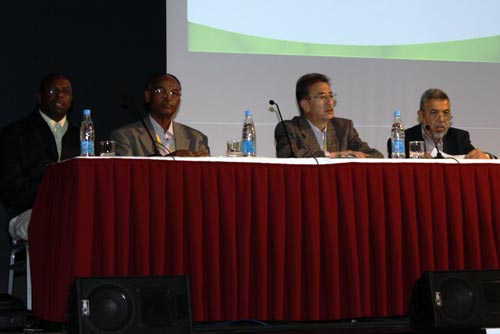 The last session (7) was panel discussion on
The last session (7) was panel discussion on  A CIMMYT team donned their expedition gear in November 2009 and set off to collect samples of teosinte, a wild relative of maize that is disappearing. The team obtained a special permit from the
A CIMMYT team donned their expedition gear in November 2009 and set off to collect samples of teosinte, a wild relative of maize that is disappearing. The team obtained a special permit from the